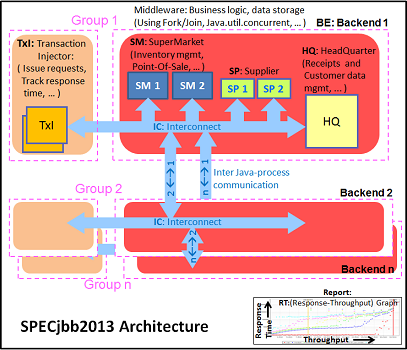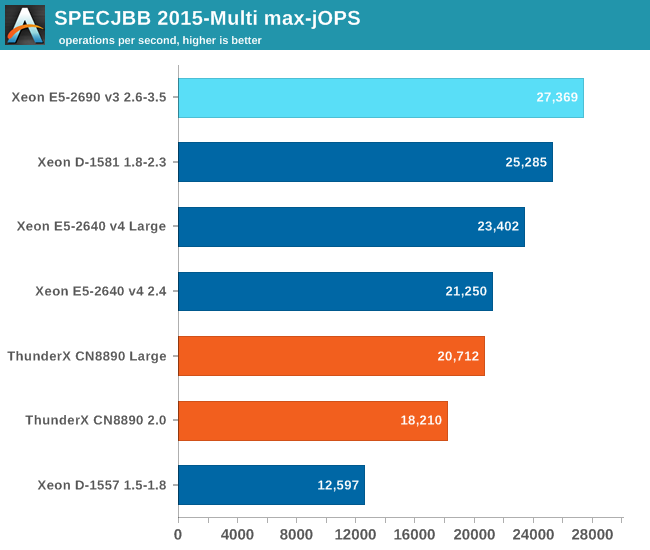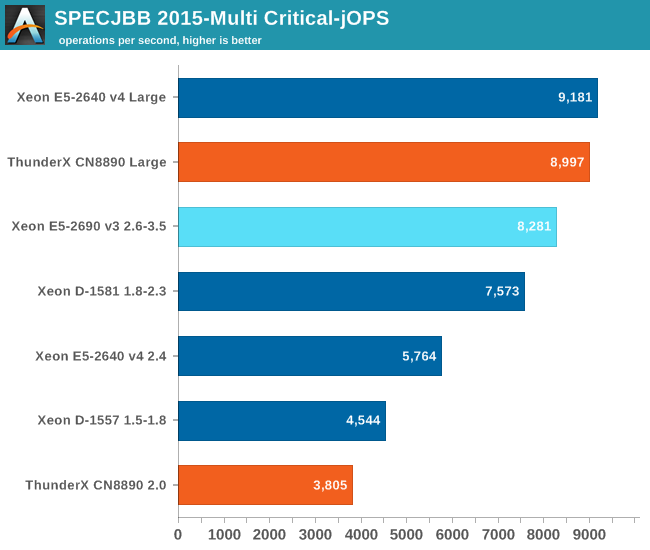Investigating Cavium's ThunderX: The First ARM Server SoC With Ambition
by Johan De Gelas on June 15, 2016 8:00 AM EST- Posted in
- SoCs
- IT Computing
- Enterprise
- Enterprise CPUs
- Microserver
- Cavium
Java Performance
The SPECjbb 2015 benchmark has "a usage model based on a world-wide supermarket company with an IT infrastructure that handles a mix of point-of-sale requests, online purchases, and data-mining operations." It uses the latest Java 7 features and makes use of XML, compressed communication, and messaging with security.

We tested with four groups of transaction injectors and backends. The Java version was OpenJDK 1.8.0_91.
We applied relatively basic tuning to mimic real-world use, while aiming to fit everything inside a server with 64 GB of RAM (to be able to compare to lower end systems):
"-server -Xmx8G -Xms8G -Xmn4G -XX:+AlwaysPreTouch -XX:+UseLargePages"
With these settings, the benchmark takes about 43-55GB of RAM. Java tends to consume more RAM as more core/threads are involved. Therefore, we also tested the Xeon E5-2640v4 and ThunderX with these settings:
"-server -Xmx24G -Xms24G -Xmn16G -XX:+AlwaysPreTouch -XX:+UseLargePages"
The setting above uses about 115 GB. The labels "large" ("large memory footprint") report the performance of these settings. We did not give the Xeon D-1581 the same treatment as we wanted to mimic the fact that the Xeon has only 4 DIMM slots, while the Xeon E5 and ThunderX have (at least) eight.
The first metric is basically maximum throughput.

Notice how the Xeon D-1581 beats the Xeon E5-2640 in a typical throughput situation by 8%, while the SPECint_rate numbers told us that the Xeon E5 would be slightly faster. It is a typical example of how running parallel instances overemphasizes bandwidth. The extra 6 cores (@2.1 GHz) push the Xeon D past the Xeon E5 (10 cores@ 2.6 GHz) despite the fact that the Xeon D has only half the bandwidth available.
The ThunderX offers low end Xeon E5 performance, but that still a lot better than what we would have expected from the SPECint_rate numbers (Dual socket ThunderX = Xeon-D). Once we offer more memory to ThunderX, performance goes up by 14%. The Xeon E5 gets a 10% performance boost.
The Critical-jOPS metric is a throughput metric under response time constraint.

The critical jOPS is the most important metric as it shows how many requests can be served in a timely manner. At first we though that the lack of single threaded performance to run the heavier pieces of Java code fast enough is what made the ThunderX so much slower than the rest of the pack.
However, the 48 threads were mostly hindered by the lack of memory per thread. Once we offer enough memory to the 48-headed ThunderX, performance explodes: it is multiplied by 2.4x! The Xeon E5 benefits too, but performance is "only" 60% higher. Thanks to the DRAM breathing room, the ThunderX moves from "slower than low end Xeon D" to "midrange Xeon E5" territory.










82 Comments
View All Comments
silverblue - Thursday, June 16, 2016 - link
I'm not sure how this is relevant. Johan doesn't review graphics cards, other people at Anandtech do. I bet Guru3D has a much bigger team for that, and I imagine that they have a much narrower scope (i.e. no server stuff).I don't think I've looked at a review recently that hasn't had the comments section polluted with "where is the review for x".
UrQuan3 - Wednesday, June 15, 2016 - link
Intel allows their Xeons to sometimes pull double their TDP? No wonder our new machines trip breakers long before I thought they would. I need to test instead of assuming accurate documentation.I can see why you chose C-Ray, I'm just sorry a more general ray tracer was not chosen. Still, not it's intended market, though I am suddenly very interested. Ray-tracing and video encoding are my top two tasks.
Meteor2 - Thursday, June 16, 2016 - link
The 'T' in 'TDP' is for thermal. It's a measure of the maximum waste heat which needs to be removed over a certain period of time.UrQuan3 - Wednesday, June 22, 2016 - link
Yes, it stands for thermal, but power doesn't consumed doesn't just disappear. Convert it to light, convert it to motion, convert it to heat, etc. In this case there is a small amount of motion (electrons) and the rest has to be heat. I expect much higher instantaneous pulls, but this was sustained power. Anyway, I will track down the AVX documentation mentioned below.I saw the h264ref. I'll be curious about x264 (handbrake) as the authors seem interested in ARM in the last few years. Unsurprisingly, it is far less optimized than x64. I benchmarked handbrake on the Pi2, Pandaboard, and CI-20 last year, just to see what it would do.
JohanAnandtech - Thursday, June 16, 2016 - link
C-Ray was just a place holder to measure FPU energy consumption. I look into bringing a more potent raytracer into our benchmark suite (povray)Video encoding was in the review though, somewhat (h264ref).
patrickjp93 - Friday, June 17, 2016 - link
ARM chips with vector extensions allow it as well. Intel provides separate documentation for AVX-workload TDPs.Antony Newman - Wednesday, June 15, 2016 - link
Fascinating article.Why would Cavium not try and use 54 x A73s in their next chip?
If ARM are not in the business of making Silicon, and ARM think the '1.2W Ares' will help them break into the Server market ... Then Why do we think ARM isn't working with the likes of Cavium to get a Server SoC that rocks the Intel boat?
Typos From memory : send -> sent. Through-> thought. There were a few others.
AJ
name99 - Thursday, June 16, 2016 - link
How do you know ARM aren't working with such a vendor?ARM has always said that they expect ARM server CPUs to only be marginally competitive (for very limited situations) in 2017, and to only be really competitive in 2020.
That suggests, among other things, that if they are working with partners, they have a target launch between those two dates, and they regard all launches before 2017 as essentially nice for PR and fr building up the ecosystem, but essentially irrelevant for commercial purposes.
rahvin - Thursday, June 16, 2016 - link
The problem as pointed out early in this article is that ARM keeps targeting Intel's current products, not the ones that will be out when they get their products out. We've had almost a dozen vendors get to the point of releasing the chip and drop it because it is simply not competitive with Intel. Most of these arm products were under taken when Intel was targeting performance without regard to performance/watt. Now that intel targets the later metric arm server chips haven't been competitive with them.Fact is Intel could decimate and totally take over all the markets arm chips occupy, but to do it they'd have to cannibalize their existing high profit sales. This is why they keep canceling Atom chips, the chips turned out so good they were worried they'd cannibalize much more expensive products. This is the reason Avoton is highly restricted in what products and price segments it's allowed into. If Intel opened the flood gates on Avoton they would risk cannibalizing their own server profits.
junky77 - Wednesday, June 15, 2016 - link
So, they did what AMD couldn't for years? I'm trying to figure it out.. their offering seems to be a lot more interesting than AMD's stuff currently